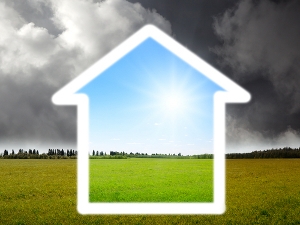 |
| Reviews and Templates for Expression We |
Are green buildings safer?

Everyone knows that green buildings use less energy to operate. And studies show they’re healthier for occupants, which makes for happier residents and more productive workers.
But safer and more durable? Seems so. A study released this week suggests that greener construction can advance building resiliency.
To me, this link seems intuitive: green buildings are generally designed and built more carefully, with better materials and tighter finishes. It turns out that efficiency-focused features may also help green buildings and their occupants ride out long-term climate shifts -- such as droughts or heat waves – and even give an edge in short-term disasters, by staying dry in floods and well sealed during high winds.
The report, produced jointly by the U.S. Green Building Council (USGBC) and the University of Michigan’s Taubman College of Architecture and Urban Planning, outlines ways to extend the inherent resiliency of green buildings. Titled "Green Building and Climate Resilience: Understanding Impacts and Preparing for Changing Conditions," it sets out adaptive strategies that green building pros can deploy. It follows that, like higher efficiency and health benefits, improved durability could boost the market appeal of green structures.
The enhanced quality of a newly built green home or office can be a visceral experience. Doors and windows shut tightly, with an audible “thunk," like an insulated fridge door. These tight seals are a huge plus for energy insulation: little heat leaks out during the winter, while cool stays in during the summer.
Better sealed, less drafty buildings are a big plus in wind storms too. When tornadoes or hurricanes rake a community, some of the most costly, serious damage is done when wind and water infiltrate a building, sending water deep into hidden cavities. A small opening -- whether a missing shingle or a poorly sealed window --can set off a domino effect of damage.
This analysis reminded me of how devastating the impacts of poorly sealed, shoddy construction can be. In 1993, The Miami Herald won a Pulitzer Prize for a Hurricane Andrew-related investigative series, which revealed that some homebuilders had systematically ignored building code to save money. On roofs, for instance, a builder used fewer nails than required by code to attach shingles to plywood or to connect roof beams to walls. The cheat saved pennies but cost billions. During Hurricane Andrew, the builders’ homes were disproportionately devastated when the roofs gave way, leaking disastrously or lifting off completely.
Water is another realm where green design can both protect buildings and enhance the environment. Permeable surfaces that let rain water soak into urban surfaces can dramatically lower the incidence of flash flooding, or overflowing from the storm water system when heavy rains overwhelm sewer systems. In drought-stricken areas, green buildings can capture rainfall, conserve fresh water and reuse grey water.
"In the wake of last year's disaster activity, with tornadoes across the southwest, flooding from Hurricane Irene and even an earthquake on the East Coast, it is important that we develop and enforce safe and sustainable building codes to make our communities more resilient, and to protect lives and property in times of disaster," Craig Fugate, administrator of the Federal Emergency Management Agency, said at the National Leadership Speaker Series on resiliency and national security this week.
He called on leaders from major corporations, government, academia, the scientific community and civil society to help advance green building as a complementary strategy to address pre- and post-emergency-management situations, ultimately forging more resilient communities, he said at the event.
Today’s building codes are designed to meet specific regional weather conditions, including the hottest summer days, the coldest winter nights, the highest wind speeds and the risk of floods. "Climate change has the potential to undermine some of these assumptions and potentially increase risks to people and property," Chris Pyke, vice president at USBGC said in a statement. "There are practical steps we can take to understand and prepare for the consequences of changing environmental conditions and reduce potential impacts."
You can download a free copy of the report at USGBC. The main body of analysis is only about 40 pages long; the report also includes another 200 pages of reference work on the impacts of climate change in different US region.
|
|
|
|
Copyright 2011 Energy and Technical Services Ltd. All Rights Reserved. Energyts.com |